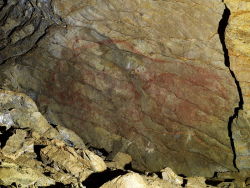Prehistoric Wall Paintings In Northern Spain Are 39,000 Thousand Years Old
These are among the earliest known cave paintings produced by humans in Europe. Were the artists modern humans, or were they Neanderthals? Scientists aren’t completely sure…
Whomever the artists were, experts have now been forced to rethink their ideas about the people who lived (and made cave paintings) in the early Upper Palaeolithic – it seems that complex and figurative art was well established much earlier than previously thought.
Cave Paintings Among the Oldest in Europe
(Popular Archaeology)
A team of scientists from the Universities of Cantabria and Burgos in Spain and Toulouse in France have dated prehistoric wall paintings in the Altxerri cave system in the Gipuzkoa province of northern Spain to about 39,000 years BPE, making them among the earliest known cave paintings produced by humans in Europe.
It was in 2011 when Cantabria University members Aitor Ruiz and César González began to explore the upper gallery of the cave, designated Altxerri B, with the objective of coming up with some reliable dates for the less-explored wall paintings in this part of the cave system. These paintings appeared to have been done independently of other paintings found in a lower gallery, paintings already with known dates that fell within the 29,000 – 35,000 BPE range. The paintings in this upper gallery were figurative representations of a bison (the most common element among the Altxerri cave system paintings) a feline, a possible animal’s head, a bear and two groups of three finger marks, as well as other motifs. Ruiz and González also employed the help of Diego Garate, a specialist in Upper Paleolithic cave art from the University of Toulouse, to help them place and interpret the paintings and their findings within the context of current knowledge about Paleolithic art in Europe…
For the complete piece click here to go to Popular Archaeology.
Share

